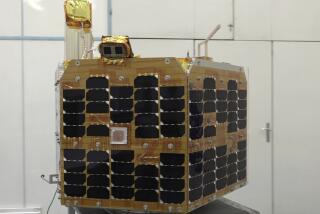Sputnik Lit a Fuse Under U.S. Space Program
- Share via
Perhaps it’s best put as a riddle: What weighed only 184 pounds but forever altered the course of American industry, prompted an overhaul of the U.S. educational system and spurred a multibillion-dollar race to space?
What was roughly the size of a beach ball but had an immeasurable impact on the American psyche and single-handedly lowered the temperature of the Cold War about 20 degrees?
In these post-Cold War days of international cooperation and global economies, it’s hard to imagine the colossal effect of that October night in 1957 when radios across this land crackled to life with the haunting announcement that the Soviet Union had launched the first satellite into space.
Sputnik.
Just the sound of the word draws chuckles today, but to those who heard the news and looked to the skies, it was as frightening a thought as there ever was.
Somewhere up there, 560 miles above Earth, loomed a whirling, mysterious reminder that the Soviet Union, America’s sworn nemesis, had beaten us into space. Worse, if the Soviets could launch a satellite into orbit, it was feared they undoubtedly had the ability to sling nuclear-tipped missiles across the continents.
At the time, it was unfathomable that the Soviets had succeeded before America did, and that they had launched something as large as Sputnik.
Although Sputnik measured only 23 inches in diameter and tipped the scales at about the weight of an average adult male, America’s rocket scientists were only hoping to lift a payload of about 21 pounds. What the Soviets had achieved was as astonishing as it was forbidding.
Moscow declared it a victory not only of technical prowess over the U.S. but also of political ideology: “The present generation will witness how the freed and conscious labor of the people of the new Socialist society turns even the most daring of man’s dreams into reality,” read the announcement out of Moscow that night.
Despite attempts to disparage the Soviets’ remarkable coup--including Rear Adm. Rawson Bennett’s much-publicized statement that the Sputnik satellite was a “hunk of iron almost anybody could launch”--most knew better.
The impact could be felt from the hushed hallways of the White House to the busy back rooms of the Jet Propulsion Laboratory in Pasadena, where some of America’s top aeronautics experts toiled away frantically in catch-up mode.
Nearly three months would pass before America, on Jan. 31, 1958, successfully launched its first satellite, Explorer 1, developed at JPL. So relieved and proud were people in Huntsville, Ala., where Explorer’s rocket was built, that many waved placards saying “Move Over, Sputnik, Space Is Ours.” Still, Explorer’s epic trek provided only so much solace.
*
There was hand-wringing, finger-pointing and a nationwide soul-searching as the country came to realize that it was not in fact the world’s leader in science and technology. The director of the American Institute of Physics, Elmer Hutchisson, proclaimed that the American way of life was “doomed to rapid extinction” if the nation’s youth weren’t properly taught the importance of science. President Dwight Eisenhower allocated the first $1 billion in direct federal aid to public education to train teachers and revolutionize math and science instruction. Not long after that, he signed into law the landmark National Defense Education Act.
The space race accelerated, with the birth of the National Aeronautics and Space Administration, the dawning of the age of intercontinental ballistic missiles and the accompanying rise to prominence of Southern California’s aerospace industry.
In the years that followed Sputnik, the Soviets established numerous other space-related firsts, including the first human in space, first human to orbit the Earth, first spacewalk, even first dog in space. America consistently ran behind until July 20, 1969, when astronaut Neil Armstrong became the first man to step onto the moon. That marked the fulfillment of a bold pledge by President John F. Kennedy, who, in 1961, had asked his top advisors what space-related goal America could realistically hope to attain before the Soviets did.
Many of the same firms that feverishly competed against the Soviets are working today with Russian counterparts on space-related enterprises. Lockheed Martin, Hughes Electronics, Motorola, all have joint ventures with Russia. Indeed, America and Russia are co-leading the effort to build an international space station in the new millennium--a concept that would have seemed as terrifying as it was implausible on the night Sputnik became a household word.
More to Read
Sign up for Essential California
The most important California stories and recommendations in your inbox every morning.
You may occasionally receive promotional content from the Los Angeles Times.













